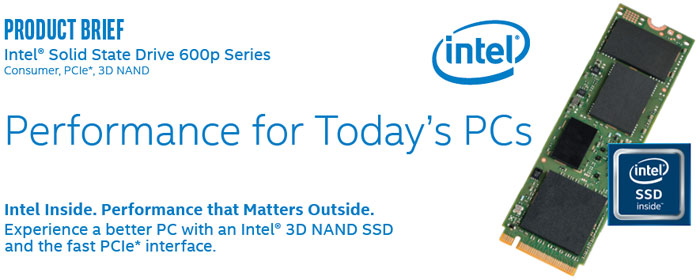Intel has announced a whole host of new SSDs. All of them use the latest 3D TLC (Tri-level cell) NAND from Micron. To address various market segments Intel has new products for mainstream consumers – the SSD 600p Series, businesses and professionals – the SSD Pro 6000p Series, Data Centre – the SSD DC P3520 Series and SSD DC S3520 Series, and for IoT – the SSD E 6000p Series and SSD E 5420s Series. It is the consumer targeted Intel SSD 600p Series storage that we will focus on in the following news report.

The new Intel SSD 600p Series proudly boasts that it is bringing PCIe to the mainstream. These drives make use of the increasingly popular M.2 form factor with PCIe Gen 3 x4 NVMe interface. Intel promises that the SSD 600p Series will "take PCs to a new level of responsiveness," offering performance about 3x faster than a SATA SSD but with similar pricing (to high-end SATA SSDs).
For a brief rundown of the drives in the range and their suggested pricing in US dollars check out the chart below:
|
Capacity |
Sequential |
Sequential |
Random |
Random |
Suggested |
|
128 GB |
770 |
450 |
35,000 |
91,000 |
$69.00 |
|
256GB |
1570 |
540 |
71,000 |
112,000 |
$104.00 |
|
512GB |
1775 |
560 |
128,500 |
128,000 |
$189.00 |
|
1024GB |
1800 |
560 |
155,000 |
128,000 |
$359.00 |

The lowest capacity drive offers a cost per gigabyte of 53 cents while the largest drive brings this value metric down to 35 cents. Other key specifications of these above SSDs are; a life expectancy of 1.6 million hours (MTBF) backed by an Intel 5 year warranty, they are 80mm long and 1.5mm thick (single sided designs), weigh 40g, and consume 100mW of power when active, 40mW when idle, and 5mW when in sleep state.
Intel's SSD Pro 6000p Series offer the same headline sizes, read/write, and IOPS performance figures as the SSD 600p Series but are priced an extra $10 at each capacity. The only difference seems to be some different firmware / software to specifically support client and workstation management, and features such as Intel Remote Secure Erase.
Most of the above products become available starting from next week but the 1TB drives arrive later, in Q4 this year.













